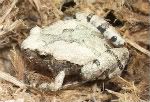While elephants may appear destructive when they pull down trees, tear up grasses or stir up soils, their impacts actually make space for the little guys: frogs and reptiles. The BBC reports that a new study in African Journal of Ecology finds that African bush elephants (Loxodonta Africana), facilitate herpetofauna (i.e. amphibians and reptiles) biodiversity when they act as ecosystem engineers.
Over six months, researchers examined amphibian and reptile populations in a number of elephant and non-elephant sites in Tanzania. A fenced-in control area with no elephants had eight species, while the area most impacted by elephants sported eighteen species. Medium and low areas of elephant impact contained 11-12 species.
According to the authors, elephants create “habitat complexity” which provides for the presence of more species.
“The habitat mosaic created by free ranging elephants helps to meet the habitat requirements of both generalists and the more sensitive species (e.g. frogs),” the authors write.
This isn’t the first study to find that elephants help amphibians. Last year a study in Sri Lanka found species of frogs making their homes in Asian elephant dung. The elephants’ massive droppings provide a micro-habitat for a variety of species, including scorpions, beetles, and spiders in addition to amphibians.
African bush elephants, the world’s largest land animal, are listed as Vulnerable by the IUCN Red List. They are threatened by habitat loss, conflict with people, and poaching for their ivory. Currently there is debate as to whether there are two species of African elephant—the bush elephant and the forest elephant—or whether they represent two subspecies.

African bush elephant tearing up grasses in Chobe National Park, Botswana. Photo by: Tiffany Roufs.
CITATION: Nasseri, N. A., McBrayer, L. D. and Schulte, B. A., The impact of tree modification by African elephant (Loxodonta africana) on herpetofaunal species richness in northern Tanzania. African Journal of Ecology, no. doi: 10.1111/j.1365-2028.2010.01238.x.
Related articles
Frogs species discovered living in elephant dung

(06/10/2009) Three different species of frogs have been discovered living in the dung of the Asian elephant in southeastern Sri Lanka. The discovery—the first time anyone has recorded frogs living in elephant droppings—has widespread conservation implications both for frogs and Asian elephants, which are in decline. “I found the frogs fortuitously during a field study about seed dispersal by elephants,” Ahimsa Campos-Arceiz, a research fellow from the University of Tokyo, told Monagaby.com.
Slaughtered elephant served up at Zimbabwean rally with president
(10/12/2010) On the menu at the most recent rally for the Zimbabwe African National Union Political Front (ZANU-PF): 3 African buffalo, 3 elephants, and a lot of smaller game according to SW Radio Africa. Attended by Zimbabwe’s President and founder of ZANU-PF, Robert Mugabe, the rally also celebrated the opening of the Women’s Celebration Bank.
A nation of tragedies: the unseen elephant wars of Chad
(05/12/2010) Stephanie Vergniault, head of SOS Elephants in Chad, says she has seen more beheaded corpses of elephants in her life than living animals. In the central African nation, against the backdrop of a vast human tragedy—poverty, hunger, violence, and hundreds of thousands of refugees—elephants are quietly vanishing at an astounding rate. One-by-one they fall to well-organized, well-funded, and heavily-armed poaching militias. Soon Stephanie Vergniault believes there may be no elephants left. A lawyer, screenwriter, and conservationist, Vergniault is a true Renaissance-woman. She first came to Chad to work with the government on electoral assistance, but in 2009 after seeing the dire situation of the nation’s elephants she created SOS Elephants, an organization determined to save these animals from local extinction.
